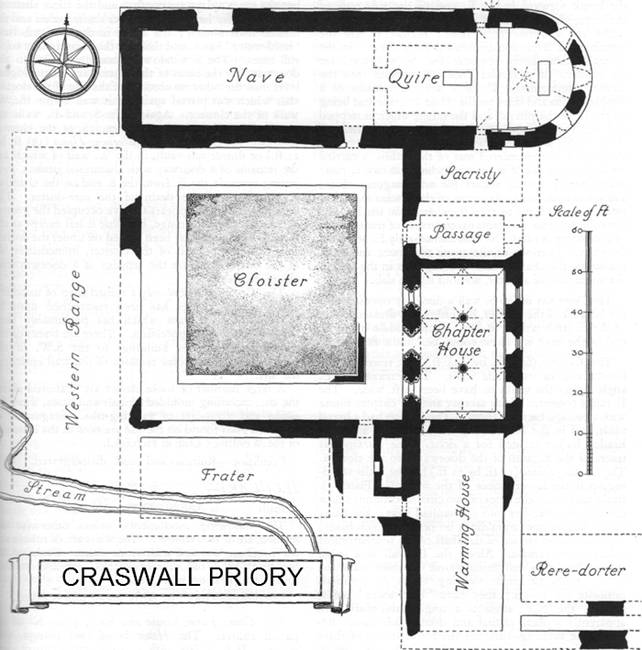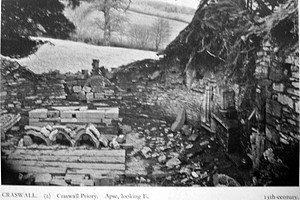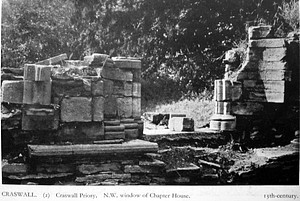Held at: | Hereford Public Library |
Reference: | Royal Commission on Historical Monuments: Herefordshire, Volume 1: H 936.244 |
Source: | Transcript of Original Publication |
Title: | Craswall Priory [Order of Grandmont]: architecture, construction and history |
Place name: | Craswall |
Date: | Up to 1700 |
Description:
(2). CRASWALL PRIORY, ruined church and claustral buildings, about 1 m. N.W. of the parish church. The Priory of St. Mary was founded for the Order of Grandmont by Walter de Lacy, Lord of Ewyas Harold c. 1220-25. As an alien priory it was suppressed in the 15th century, but the buildings were apparently left standing to fall gradually into ruins or to be used as a quarry.
Craswall was the second of the three houses of the order founded in England, and as such the ruins are of unusual interest.

The Priory Church consisted of a Chancel (24 ½ ft. from E. to W. by 25 ft.) with a semi-circular apsidal E. end and a Nave (83 ½ ft. by 23 ½ ft.) the side walls of which are brought forward internally about 11 in. or 12 in. in front of the side walls of the chancel. At the E. end of the building the walls are now standing only 5 ft. or 6 ft. above the floor-level, but they rise in height towards the W. end of the chancel, and the side walls of the nave are about 10 ft. to 12 ft. in height.
The Apse (Plate 87) appears to have had three windows; parts of the W. splays of the two outer windows remain, and an open gap in the wall behind the altar may represent the middle window. The Chancel has in the W. end of the N. wall, immediately adjoining the break forward in the E. end of the side wall of the nave, the remains of a doorway with chamfered jambs and a semi-circular head; further E. are the remains of a large locker rebated for a door. In the S. wall, immediately opposite the N. doorway, are the remains of a similar doorway opening into the sacristy; immediately E. of it are the remains of a double piscina and three sedilia (Plate 87), one seat being on the E. of the piscina and the other, which is stepped and for two persons, on the W.; the E. jamb of the E. sedile is moulded, as is also the W. jamb of the W. sedile ; the chamfered seat of the sedilia is carried up to form the sill of the piscina which has two circular drains and a central socket for an octagonal shaft; a few roll-moulded jamb-stones of the piscina remain in position. A chapel flanked the chancel on the N. side, but of this nothing remains except traces of the springer of a stone vault on the N. wall immediately E. of the N. doorway. Portions of the stone pavement and steps remain in the chancel, and standing free in the apse is the stone base of an altar, without its top slab.
The Nave has in the S. wall a doorway opening into the N. walk of the cloister, but only a few dressed stones of the E. jamb remain in situ. In the middle of the E. end of the nave is a stone coffin, below the floor-level.
The Cloister (67 ½ ft. by 64 ½ ft.) has traces of the foundations of its arcade walls. The excavated S.E. angle shows the walks to have been 10 ft. wide. The E. range consisted of the sacristy and the chapter house with a passage between them. The Sacristy had a barrel vault, and in the N. wall are the remains of a round-headed locker rebated for a door. The Passage has traces of the S. jamb of the doorway into the cloister. The Chapter House (37 ft. by 21 ft.) has the walls standing up to the lower stones of the windows (Plate 87). In the middle are the bases of two circular columns which divided the chamber into six vaulted bays; the bases have ' hold-water ' mouldings on octagonal sub-bases; the three lower stones of the shaft of the southernmost column also remain. Along the E. wall is a ledge formed by a moulded string-course on which stand the lower stones of triple vaulting shafts or responds opposite the pillars; they have ' hold-water ' bases, and in the N.E. angle is a single vault-shaft with apparently a plain capital and double roll base. Between the vaulting-shafts are the lower stones of three E. windows with filleted angle-rolls to the splays. In the S. wall are the remains of a doorway which may have been inserted later. In the middle bay of the W. wall is the entrance doorway from the cloister, and in each of the side bays is a window (Plate 87). The doorway has splayed jambs of two orders with an attached triple shaft to the inner order and two detached shafts on each side of the outer order; the ' hold-water ' bases of all of these remain. The N. window has jambs of similar character to those of the doorway, but the outer splays are concave and the triple shafts of the inner order have the two outer shafts keeled and the middle shaft filleted; the shafts to the N. jamb have ' hold-water ' bases, and those to the S. jamb have triple roll bases. The S. window is generally similar to the doorway, but the bases of the S. jamb are set at a higher level than the other on account of the rise of the dorter-stair which was placed against this wall within the W. walk of the cloister. Against the S. and E. walls are traces of the original stone benches. S. of the chapter house are the remains of the Warming-House (38 ½ ft. by 21 ft.) or dorter sub-vault, in the W. wall of which are the remains of a doorway with chamfered jambs ; projecting towards the E. from the S. end of the chamber are portions of the drain of the rere-dorter. The Prater (19 ft. wide) appears to have occupied the greater part of the southern range, but little is left except at E. end, where part has been walled off under the dorter-stair. In the S. wall of the cloister, immediately W. of the dorter-stair, are the remains of a doorway with chamfered jambs.
The W. range is now only a ruined heap of masonry, and the S.W. corner has been encroached upon by the contiguous stream which has presumably been diverted since the suppression. There are traces of the foundations of other buildings to the S.W. of the claustral block and some remains of the wall enclosing the site.
A large number of loose stones are scattered about the site, including moulded capitals and bases, window-jambs and voussoirs of vaulting-ribs. Fragments of coloured glass found on the site are now in the Museum of the Woolhope Club at Hereford.
Condition—Ruinous and much disintegrated.
|
|
Plate 87 | Plate 87 |
Observations:
Description documented c 1930 by the Royal Commission on Historical Monuments.
See also ‘The Priory and Manor of Craswall’ by CJ Lilwall, 1904.
Ordnance Survey Map Reference and Index of Parish Properties
Ref: rs_cra_0126


